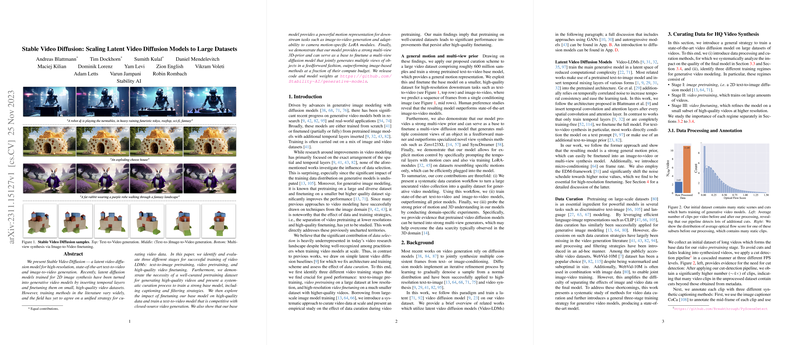Introduction to Video Synthesis Techniques
Generative models have made significant strides in synthesizing high-quality images, and the pursuit to extend this success to video generation has been a focal area of research. Video generative models have typically evolved from their image-based counterparts, with researchers modifying existing architectures by introducing temporal layers and adjusting training regimes. However, the influence of the training data and its curation has been somewhat overlooked, even though it's widely acknowledged that the data distribution profoundly impacts generative model performance. This paper tackles these unexplored aspects and presents a method for scaling latent video diffusion models to large datasets with a focus on text-to-video and image-to-video applications.
Systematic Approach to Data Curation
The paper begins by dissecting the video training process into three critical stages: text-to-image pretraining, video pretraining, and high-quality video finetuning. It posits that the pretraining phase must occur on a well-curated dataset—a dataset distilled from a large unfiltered collection to remove clips with limited motion and other unwanted characteristics. Through empirical analysis, the authors show that pretraining on such refined datasets leads to substantial improvements that carry over even after the finetuning stage.
Innovations in Video Diffusion Models
The core of the presented Stable Video Diffusion (SVD) approach lies in its robust base model trained on approximately 600 million video clips. This model acts as a springboard for further task-specific finetuning—for text-to-video generation, for instance, human evaluators favored the results over current state-of-the-art methods. Not only does SVD handle direct text-to-video synthesis effectively, but it also adapts to image-to-video generation where sequences are generated from a single image input, demonstrating the model's potent motion understanding.
Expanding into Multi-View and 3D Spaces
One of the paper's pivotal claims is the model's ability to serve as a multi-view 3D-prior. After finetuning on appropriate datasets, the SVD showcases its proficiency in generating multiple consistent views of an object in a feedforward fashion, achieving superior performance to several specialized techniques, while also requiring significantly less computational resources. Additionally, it introduces the adaptability to control motion through camera motion-specific LoRA modules, underscoring the model's versatility.
Conclusion and Implications
The authors conclude by affirming the importance of data curation and training strategy segmentation for video diffusion models. They present SVD as a generative video model that not only excels in high-resolution text-to-video and image-to-video synthesis but also sets new standards in multi-view consistency and efficiency in generative video modeling. With code and model weights publicly released, the authors invite further exploration and adoption of their findings in the broader video research community. This transparency ensures that SVD's contributions to the generative video modeling field will continue to foster innovation and refinement in AI-powered video synthesis.
